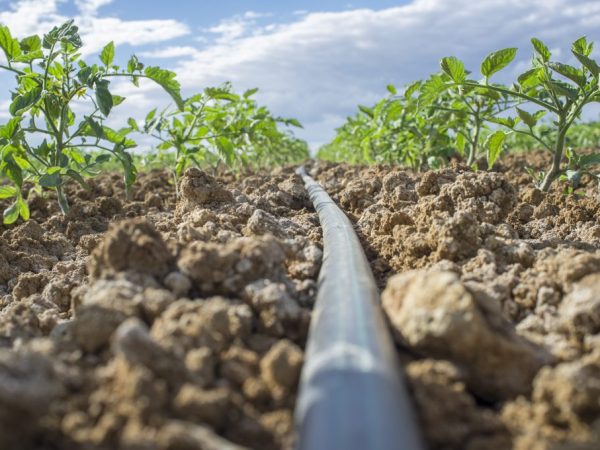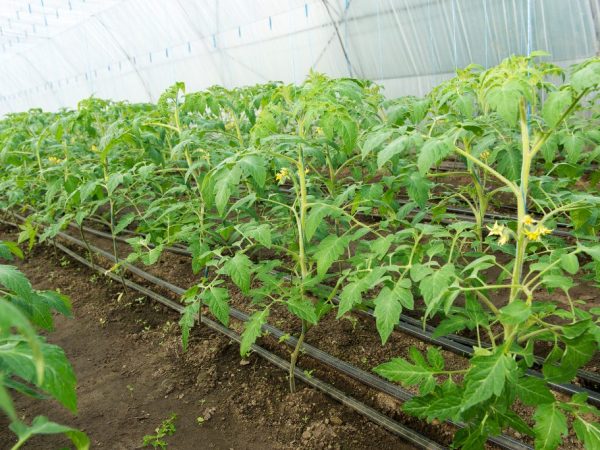Drip irrigation rules for a tomato
The sale of vegetable crops is now very common in the consumer market. Planting and growing tomatoes is especially revered among farmers. But, like any plant, the bush requires proper care and attention, especially the crops are in urgent need of irrigation. Drip irrigation of a tomato is one of the most effective irrigation systems that allows you to correctly and in time to add the necessary moisture to the soil and supply vegetables with nutrients.

Drip irrigation rules for a tomato
Method description
The most optimal solution for growing vegetables in open ground or in greenhouse conditions is drip irrigation of tomatoes, then a sufficient amount of water will always be introduced into the soil. The essence of the method is to draw water through a hose located along the perimeter of the beds due to pressure and to carry out a uniform flow of water.
The advantage of the method is its functionality, it not only irrigates the soil, but also frees you from the exhausting manual application of liquid to the soil. Another advantage is the fact that with the help of drip irrigation of tomatoes in the greenhouse, you can do the work twice as fast, while water will enter all the beds in the right amount. With the help of such a system, it is very easy to comply with the required watering regime.
If you are growing tomatoes in a greenhouse, drip irrigation is the best solution for you, just like outdoors. The system is designed to water vegetables, house plants, flowers in the garden. Thanks to the automatic irrigation system, water is distributed only to the desired plants, which prevents weeds from growing.
Irrigation rules for crops
In order for drip irrigation of tomatoes to bring the expected benefits, you should adhere to the general irrigation recommendations when growing vegetables in a greenhouse. Tomato species thrive in moist soil, but the air needs to be dry. Therefore, it is not recommended to aerate the soil immediately after irrigation - these manipulations will dry it out and the desired effect will not come out. The most optimal would be to fertilize the ground with freshly cut grass, such actions will retain moisture.
Liquid application rules:
- it should be watered under the root system, the main thing is to make sure that with your actions you do not wash the rhizome;
- in order to avoid diseases, try to prevent the leaves and stems from getting wet in the greenhouse, excessive moisture may be created;
- all water procedures should be carried out in the morning;
- the liquid must be warmed up to 22-24 ° C;
- improper care can lead to excessive evaporation of moisture through the leaves, which will lead to the death of the plant;
- vegetable culture requires abundant, but not frequent introduction of liquid, in order to avoid dampness and suppuration.
It is optimal to carry out the water procedure several times a week. For each bush, you will need about 4 liters of water.
Irrigation systems

The drip irrigation system can be done by yourself
Dripper systems for watering vegetables can be of different types.
- Katif - a device for irrigation on an industrial scale, made from a hose of elastic structure, the width of the walls should be no more than 15 mm.
- Supertyf is an external dropper with a flow rate of up to 2 liters per hour, which is designed to irrigate several beds at once. Such a device can be installed on steep slopes and not worry about excessive fluid consumption.
- Also, in your personal garden, you can do without any devices and make a system with your own hands, for example, with plastic bottles. To do this, you need to take a bottle, make several holes in it with an awl at a distance of 3-4 cm from the bottom and dig in the container to a depth of 10-12 cm down between the plants.
- The system of automatic irrigation, Signor Tomato, is a drip tape, which is designed for 100 m of beds. It runs on a battery and does not need to be charged with electricity because it is powered by the sun.
With each of these systems, it is quite easy to comply with the irrigation regime, which is so necessary for growing shrubs and adult crops.
Installation methods
Katif and Supertyf
The installation and operation of the Katif and Supertyf droppers are very similar. In order to make an irrigation system, we need to insert droppers into the hose with our own hands:
- we make holes of the right size;
- make sure that the holes are even;
- make sure that all the tubes are well connected to the holes.
A distinctive feature of the Supertyf installation is that the hose is inserted on special supports and is located along the perimeter of the garden. Such a system is capable of watering tomatoes in four directions at once. Depending on how much water you need for irrigation, you can choose devices with different capacities.
Installing a homemade dropper
To make an eco-grower for tomatoes outdoors or indoors, you can use ordinary plastic bottles. In this case, you will do without automation and save a lot of money.
You will need to get plastic bottles for each garden bed, it is advisable to take two-liter bottles. To begin with, properly prepare the container, it needs to be thoroughly washed from the remnants of lemonade or other drinks.
- In the lid, make up to seven holes, cut the bottom of the bottle.
- Dig each bottle next to a tomato bush 10 cm deep.
- Lead a hose to each container through which water will be supplied.
By filling the container, the liquid will slowly seep through the holes and nourish the root system.


